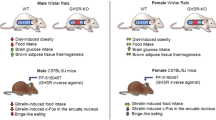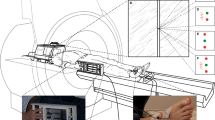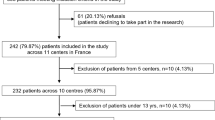Abstract
Benzodiazepine receptor inverse agonists reduce food intake in males, but their actions in females, in whom stress-related eating disorders are more common, as well as their behavioral mode of action remain unclear. The consummatory effects of benzodiazepine receptor ligands have alternately been hypothesized to reflect changes in the hedonic evaluation of food or secondary effects of anxiety-related or cognitive properties. To test the anorectic mode of action of benzodiazepine inverse agonists, the effects of FG 7142 on feeding microstructure were studied in nondeprived female Wistar rats (n=32). Microstructure analysis used a novel meal definition that recognizes prandial drinking. On pharmacologically synchronized diestrus I, rats were pretreated (−30 min dark onset) with the benzodiazepine partial inverse agonist FG 7142 (i.p. 0, 3.75, 7.5, 15 mg/kg) in a between-subjects design. FG 7142 delayed the onset of (16–541%), decreased the amount eaten (36–52%) and drunk (63–87%), and reduced the time spent drinking (59–87%) within the first nocturnal meal. Dose-dependent incremental anorexia continued 6 h into the dark cycle, whereas FG 7142 did not suppress the quantity, duration or rate of drinking past the first meal. Treated rats ate smaller meals (17–42%) of normal duration. This reflected that FG 7142 slowed feeding within meals (9–38%) by decreasing the regularity and maintenance of feeding from pellet-to-pellet. FG 7142 did not influence postprandial satiety; meal frequency and inter-meal intervals were unaffected. FG 7142 anorexia was blocked by the benzodiazepine receptor antagonist flumazenil in a 2:1 molar ratio (n=17 rats). The very early, nonspecific (+10 min), but not subsequent (2.5, 4.5 h) feeding-specific phase, of FG 7142 anorexia was mirrored by anxiogenic-like behavior in FG 7142-treated (7.5 mg/kg) female rats (n=48) in the elevated plus-maze. Thus, benzodiazepine receptor inverse agonists preferentially lessen the maintenance of feeding in female rats, effects opposite to those of palatable food.
Similar content being viewed by others
Log in or create a free account to read this content
Gain free access to this article, as well as selected content from this journal and more on nature.com
or
References
Bernard PS, Pastor G, Liebman JM (1986). CGS 8216, a benzodiazepine antagonist, reduces food intake in food-deprived rats. Pharmacol Biochem Behav 24: 1703–1706.
Carrillo CA, Zorrilla EP, Koob GF (2001). The effects of naltrexone, a non-selective opiate receptor antagonist, on the consumption of sweetened food and solutions. AAAS Annual Meeting & Science Innovation Exposition, San Francisco, 167, abstr# A85.
Chan A, Dudley CA, Moss RL (1984). Hormonal and chemical modulation of ventromedial hypothalamic neurons responsive to vaginocervical stimulation. Neuroendocrinology 38: 328–336.
Chen SW, Davies MF, Loew GH (1995). Food palatability and hunger modulated effects of CGS 9896 and CGS 8216 on food intake. Pharmacol Biochem Behav 51: 499–503.
Chouinard G (2004). Issues in the clinical use of benzodiazepines: potency, withdrawal, and rebound. J Clin Psychiatry 65 (Suppl 5): 7–12.
Clifton PG, Cooper SJ (1996). The benzodiazepine partial receptor agonist, bretazenil, provokes a strong hyperphagic response: a meal pattern analysis in free feeding rats. Behav Pharmacol 7: 454–461.
Cooper SJ (1986). Hyperphagic and anorectic effects of beta-carbolines in a palatable food consumption test: comparisons with triazolam and quazepam. Eur J Pharmacol 120: 257–265.
Cooper SJ (2005). Palatability-dependent appetite and benzodiazepines: new directions from the pharmacology of GABA(A) receptor subtypes. Appetite 44: 133–150.
Cooper SJ, Barber DJ, Gilbert DB, Moores WR (1985). Benzodiazepine receptor ligands and the consumption of a highly palatable diet in non-deprived male rats. Psychopharmacology (Berlin) 86: 348–355.
Cooper SJ, Bowyer DM, Van der Hoek G (1989). Effects of the imidazobenzodiazepine Ro 15-4513 on saccharin choice and acceptance, and on food intake, in the rat. Brain Res 494: 172–176.
Cooper SJ, Estall LB (1985). Behavioural pharmacology of food, water and salt intake in relation to drug actions at benzodiazepine receptors. Neurosci Biobehav Rev 9: 5–19.
Cooper SJ, Kirkham TC (1993). Opioid mechanisms in the control of food consumption and taste preferences. In: Herz A (ed). Handbook of Experimental Pharmacology: II. Opioids II, Vol. 104. Springer-Verlag: Berlin. pp 239–262.
Cooper SJ, Moores WR (1985). Chlordiazepoxide-induced hyperphagia in non-food-deprived rats: effects of Ro15-1788, CGS 8216 and ZK 93 426. Eur J Pharmacol 112: 39–45.
Cooper SJ, Yerbury RE (1986a). Midazolam-induced hyperphagia and FG 7142-induced anorexia: behavioural characteristics in the rat. Pharmacol Biochem Behav 25: 99–106.
Cooper SJ, Yerbury RE (1986b). Benzodiazepine-induced hyperphagia: stereospecificity and antagonism by pyrazoloquinolines, CGS 9895 and CGS 9896. Psychopharmacology (Berlin) 89: 462–466.
Cruz AP, Frei F, Graeff FG (1994). Ethopharmacological analysis of rat behavior on the elevated plus-maze. Pharmacol Biochem Behav 49: 171–176.
Dawson GR, Maubach KA, Collinson N, Cobain M, Everitt B, Macleod A et al (2005). An inverse agonist selective for {alpha}5 subunit-containing GABAA receptors enhances cognition. J Pharmacol Exp Ther 316: 1335–1345.
Dekhuijzen AJ, Bagust J (1996). Analysis of neural bursting: nonrhythmic and rhythmic activity in isolated spinal cord. J Neurosci Methods 67: 141–147.
Fernandes C, File SE (1996). The influence of open arm ledges and maze experience in the elevated plus-maze. Pharmacol Biochem Behav 54: 31–40.
Higgs S, Cooper SJ (1996). Effects of the benzodiazepine receptor inverse agonist Ro 15-4513 on the ingestion of sucrose and sodium saccharin solutions: a microstructural analysis of licking behavior. Behav Neurosci 110: 559–566.
Higgs S, Cooper SJ (1998). Effects of benzodiazepine receptor ligands on the ingestion of sucrose, intralipid, and maltodextrin: an investigation using a microstructural analysis of licking behavior in a brief contact test. Behav Neurosci 112: 447–457.
Hinton EC, Parkinson JA, Holland AJ, Arana FS, Roberts AC, Owen AM (2004). Neural contributions to the motivational control of appetite in humans. Eur J Neurosci 20: 1411–1418.
Hunt T, Poulos CX, Cappell H (1988). Benzodiazepine-induced hyperphagia: a test of the hunger-mimetic model. Pharmacol Biochem Behav 30: 515–518.
Kelley AE, Bakshi VP, Fleming S, Holahan MR (2000). A pharmacological analysis of the substrates underlying conditioned feeding induced by repeated opioid stimulation of the nucleus accumbens. Neuropsychopharmacology 23: 455–467.
Kelley AE, Baldo BA, Pratt WE, Will MJ (2005). Corticostriatal-hypothalamic circuitry and food motivation: integration of energy, action and reward. Physiol Behav 86: 773–795.
Li CS, Davis BJ, Smith DV (2003). Opioid modulation of taste responses in the nucleus of the solitary tract. Brain Res 965: 21–34.
Li JS, Huston JP (2002). Non-linear dynamics of operant behavior: a new approach via the extended return map. Rev Neurosci 13: 31–57.
Lowe MR, Levine AS (2005). Eating motives and the controversy over dieting: eating less than needed versus less than wanted. Obes Res 13: 797–806.
Mittleman G, Jones GH, Robbins TW (1988). Effects of diazepam, FG-7142, and Ro-15-1788 on schedule-induced-polydipsia and the temporal control of behavior. Psychopharmacology 94: 103–109.
Morgan CA, Emmans GC, Tolkamp BJ, Kyriazakis I (2000). Analysis of the feeding behavior of pigs using different models. Physiol Behav 68: 395–403.
O’Brien CP (2005). Benzodiazepine use, abuse, and dependence. J Clin Psychiatry 66 (Suppl 2): 28–33.
O'hare E, Kim EM, Tierney KJ (2006). An operant determination of the behavioral mechanism of benzodiazepine enhancement of food intake. Psychopharmacology (Berlin) 187: 138–142.
Patel SM, Ebenezer IS (2002). The effects of the benzodiazepine receptor ligand 3-(methoxycarbonyl) amino-beta-carboline on food and water intake in rats. Methods Find Exp Clin Pharmacol 24: 681–683.
Pfaus JG, Smith WJ, Byrne N, Stephens G (2000). Appetitive and consummatory sexual behaviors of female rats in bilevel chambers. II. Patterns of estrus termination following vaginocervical stimulation. Horm Behav 37: 96–107.
Randall LO (1960). Pharmacology of methaminodiazepoxide. Dis Nerv Syst 21 (Suppl 3): 7–10.
Randall LO, Schallek W, Heise GA, Keith EF, Badgon RE (1960). The psychosedative properties of methaminodiazepoxide. J Pharmacol Exp Ther 129: 163–171.
Richardson DK, Reynolds SM, Cooper SJ, Berridge KC (2005). Endogenous opioids are necessary for benzodiazepine palatability enhancement: naltrexone blocks diazepam-induced increase of sucrose-‘liking’. Pharmacol Biochem Behav 81: 657–663.
Richardson HN, Zorrilla EP, Mandyam CD, Rivier CL (2006). Exposure to repetitive versus varied stress during prenatal development generates two distinct anxiogenic and neuroendocrine profiles in adulthood. Endocrinology 147: 2506–2517.
Rivier C, Vale W (1990). Cytokines act within the brain to inhibit luteinizing hormone secretion and ovulation in the rat. Endocrinology 127: 849–856.
Rivier J, Amoss M, Rivier C, Vale W (1974). Synthetic luteinizing hormone releasing factor. Short chain analogs. J Med Chem 17: 230–233.
Rudolph U, Möhler H (2004). Analysis of GABAA receptor function and dissection of the pharmacology of benzodiazepines and general anesthetics through mouse genetics. Annu Rev Pharmacol Toxicol 44: 475–498.
Sanchez Gomez PP, Troop NA, Treasure JL (2002). Psychophysiology and eating disorders. In: D’Haenen H, den Boer JA, Willner P (eds). Biological Psychiatry. John Wiley & Sons, Ltd: Chichester. pp 1159–1165.
Shannon CE, Weaver W (1949). The Mathematical Theory of Communication. University of Illinois Press: Urbana.
Sharp J, Zammit T, Azar T, Lawson D (2003). Stress-like responses to common procedures in individually and group-housed female rats. Contemp Top Lab Anim Sci 42: 9–18.
Sieghart W, Sperk G (2002). Subunit composition, distribution and function of GABA(A) receptor subtypes. Curr Top Med Chem 2: 795–816.
Szücs A, Pinto RD, Rabinovich MI, Abarbanel HD, Selverston AI (2003). Synaptic modulation of the interspike interval signatures of bursting pyloric neurons. J Neurophysiol 89: 1363–1377.
Tolkamp BJ, Schweitzer DPN, Kyriazakis I (2000). The biologically relevant unit for the analysis of short-term feeding behavior of dairy cows. J Dairy Sci 83: 2057–2068.
Yerbury RE, Cooper SJ (1987). The benzodiazepine partial agonists, Ro16-6028 and Ro17-1812, increase palatable food consumption in nondeprived rats. Pharmacol Biochem Behav 28: 427–431.
Zorrilla EP, Inoue K, Fekete EM, Tabarin A, Valdez GR, Koob GF (2005a). Measuring meals: structure of prandial food and water intake of rats. Am J Physiol Regul Integr Comp Physiol 288: R1450–R1467.
Zorrilla EP, Inoue K, Valdez GR, Tabarin A, Koob GF (2005b). Leptin and post-prandial satiety: acute central leptin more potently reduces meal frequency than meal size in the rat. Psychopharmacology 177: 324–335.
Acknowledgements
This is manuscript 18047 from The Scripps Research Institute. We gratefully recognize the editorial assistance of Mike Arends, the technical assistance of Bob Lintz, and the scholarly input of Dr Brendan Walker and two anonymous reviewers. This research was supported by DK64871 from the National Institute of Diabetes and Digestive and Kidney Diseases.
Author information
Authors and Affiliations
Corresponding authors
Rights and permissions
About this article
Cite this article
Cottone, P., Sabino, V., Steardo, L. et al. FG 7142 Specifically Reduces Meal Size and the Rate and Regularity of Sustained Feeding in Female Rats: Evidence that Benzodiazepine Inverse Agonists Reduce Food Palatability. Neuropsychopharmacol 32, 1069–1081 (2007). https://doi.org/10.1038/sj.npp.1301229
Received:
Revised:
Accepted:
Published:
Issue date:
DOI: https://doi.org/10.1038/sj.npp.1301229
Keywords
This article is cited by
-
The Trace Amine-Associated Receptor 1 Agonist RO5256390 Blocks Compulsive, Binge-like Eating in Rats
Neuropsychopharmacology (2017)
-
Pituitary adenylate cyclase-activating polypeptide (PACAP) in the central nucleus of the amygdala induces anxiety via melanocortin receptors
Psychopharmacology (2016)
-
Pituitary Adenylate Cyclase-Activating Peptide in the Central Amygdala Causes Anorexia and Body Weight Loss via the Melanocortin and the TrkB Systems
Neuropsychopharmacology (2015)
-
Psychopharmacological characterisation of the successive negative contrast effect in rats
Psychopharmacology (2015)
-
High Trait Impulsivity Predicts Food Addiction-Like Behavior in the Rat
Neuropsychopharmacology (2014)



